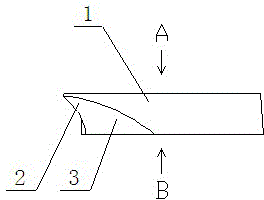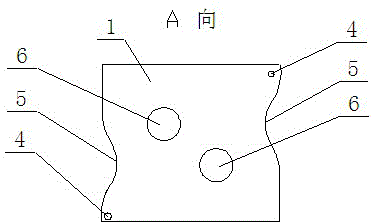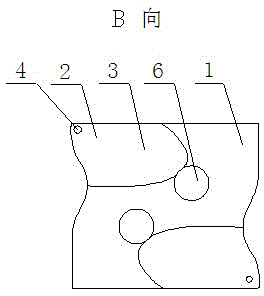Processing technique for manufacturing textile lead alloy wires by lead alloy bars
A processing technology, lead alloy technology, applied in the field of anti-nuclear radiation, can solve the problems of large occupied area and high cost, and achieve the effect of occupying less production area, low cost and high production efficiency
- Summary
- Abstract
- Description
- Claims
- Application Information
AI Technical Summary
Problems solved by technology
Method used
Image
Examples
Embodiment Construction
[0018] 1. Tool processing:
[0019] like figure 1 , 2 As shown in . and 3, it is a tool of an aluminum alloy rod wire forming device, including a cuboid tool body 1, two mounting holes 6 are set in the middle of the tool body 1, and two arc-shaped fitting surfaces 2 and two A waste material surface 3, extrusion holes 4 are respectively arranged on the corners of the tool body 1 at each fitting surface 2, and two fitting surfaces 2 and two extrusion holes 4 are respectively arranged on a pair of pairs of the cutter body 1. On the corner, avoidance surfaces 5 are respectively provided on the side of the tool body 1 on one side of each extrusion hole 4 , and two avoidance surfaces 5 are respectively arranged on the front and rear sides of the cutter body 1 .
[0020] One of the above-mentioned extrusion holes 4 has a diameter of 1 mm, and one of the other extrusion holes 4 has a diameter of 1.20 mm.
[0021] 2. Production process:
[0022] 1. Turn on the machine tool first, a...
PUM
| Property | Measurement | Unit |
|---|---|---|
| diameter | aaaaa | aaaaa |
| diameter | aaaaa | aaaaa |
Abstract
Description
Claims
Application Information
 Login to View More
Login to View More - R&D
- Intellectual Property
- Life Sciences
- Materials
- Tech Scout
- Unparalleled Data Quality
- Higher Quality Content
- 60% Fewer Hallucinations
Browse by: Latest US Patents, China's latest patents, Technical Efficacy Thesaurus, Application Domain, Technology Topic, Popular Technical Reports.
© 2025 PatSnap. All rights reserved.Legal|Privacy policy|Modern Slavery Act Transparency Statement|Sitemap|About US| Contact US: help@patsnap.com



